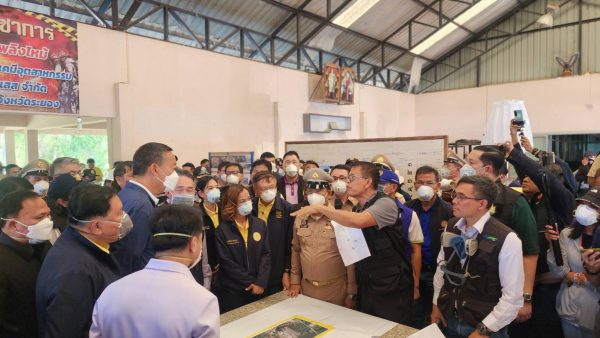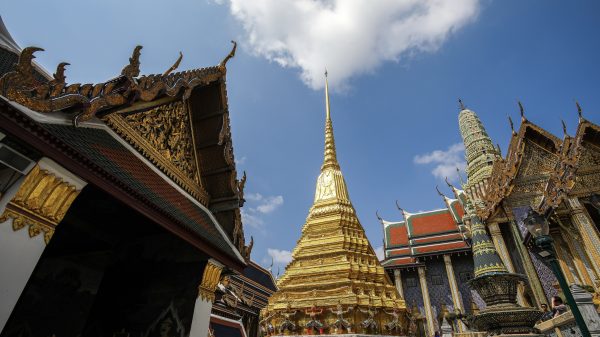The “October spirit” and Thailand’s slow democratic transition

Every October in Thailand, public events are held to remember the two massacres of anti-dictatorship protesters by state forces that took place half a century ago.
Experts say that, while the spirit of the “October Movement” remains strong, it has not succeeded in changing social and political structures that led to the bloody events of October 14th, 1973, and October 6th, 1976.
“I have hardly seen any change in Thailand’s political structure … The military still wields strong political influence. It also seems ready to intervene in politics at any time,” said Somchai Homlaor, advisor to the Cross-Cultural Foundation, which seeks justice for victims of human rights abuses at the hands of authorities.
Somchai is a veteran of the student activities which led to the October 14th popular uprising and crackdown and the October 6th massacre.
The lack of structural changes in Thailand meant the country has suffered military coups in almost every decade of the past half-century, he said.
Although Thai laws had gradually shown greater respect for human rights, enforcement remained weak because government agencies and traditional organisations had hardly changed their line, he added.
“I have not yet seen any changes that will pave the way to a truly democratic society in Thailand,” he commented.
Any hope?
Somchai is, however, encouraged that the spirit of the October Movement still runs strong in many Thais – particularly the young generation. More people are determined to bring progressive change to key social and political structures too, he added. Despite military coups and state crackdowns, demonstrators have continued to come out on the streets to demand true democracy over the past few decades, “So, I think there is some kind of progress,” he said.
Chaipong Samnieng, who teaches history at the Naresuan University’s Faculty of Social Sciences and is an expert on the October 14th and October 6th massacres, describes the events as milestones in the nation’s political history.
“The spirit of the people who took part in the October Movement back then has created the contemporary ideology we see today. That’s why, even though half a century has passed, we are still talking about what happened,” he said.
The October incidents inspired people to dream of a country where power is in the hands of ordinary people, who wield neither weapons nor special influence, Chaipong added.
Chaipong said his students, even now, are keen to learn more about the October 6th massacre, which they find relevant to their lives. They research the incident and sometimes come up with new information that sheds more light on the terrible events of that day.
“Young people show more interest in October 6th than October 14th, because the former shows how Thailand’s transformation to a true democracy was blocked,” he said. “The October 6th incident may not be mentioned in official textbooks, but it has always attracted public interest.”
Even though the protests all those years ago were ended by crackdowns, their ideology has prevailed and guided each new generation of Thais. The ideological landscape among Thai youth may have altered over the years, but it has always kept alive the spirit of the October Movement.
Who are the ‘Octobrists’?
One of the country’s top experts on the October Movement is Kanokrat Lertchoosakul, who lectures in political science at Chulalongkorn University and wrote the book, “The Rise of the Octobrists in Contemporary Thailand: Power and Conflict among Former Left-Wing Student Activists in Thai Politics”.
It defines “Octobrists” as school and university students who played a role in opposing the dictatorships of Field Marshal Thanom Kittikachorn and Field Marshal Praphas Charusathien before and during the October 14th incident, as well as those who actively engaged in the October Movement between 1973 and 1976, up to the October 6th massacre, and those who joined or supported the Communist Party of Thailand thereafter.
What happened?
In 1973, students and pro-democracy Thais were protesting against military rule, which had lasted since 1959, demanding a new constitution, an election and a parliamentary system of constitutional monarchy. On October 14th, the popular uprising met with a deadly crackdown by police and troops that left at least 77 dead. Thanom’s regime resigned on the same day.
In 1974, Thailand got a new constitution, which better reflected democratic principles, but the elected government was weak, with the military and “invisible hands” controlling affairs behind the scenes.
In 1976, after students, farmers and pro-democracy activists pressed for more welfare, in line with democratic rights, several of their leaders were assaulted or even assassinated. Growing tensions then threatened to explode with the news that Thanom was preparing to sneak back into Thailand, after fleeing the country in the aftermath of the uprising three years earlier.
Students took to the streets in protest. Right-wing paramilitary groups and police then surrounded Thammasat University, where a prolonged rally was being held, and began firing on the student protesters inside.
They then stormed the university grounds and dragged many of the students out onto Sanam Luang, a large adjacent field, before beating and lynching them to death. Estimates of the death toll range from 46 to over 100.
The military seized power the same night and began hunting down student activists accused of being communist sympathizers. Hundreds managed to escape to join the Communist Party of Thailand (CPT) which, at the time, was gaining significant ground in many areas around the country.
Kanokrat explained that students joined the CPT because it was their only hope. Back then, the pro-China communist party seemed the only institution powerful enough to be able to challenge the right-wing establishment. She added that the October 14th uprising and the October 6th massacre also invoked different feelings in people. Those who identify with the former remember their victory and feel closer to the monarch, King Rama 9, who is credited with ending the deadly crackdown. Those who resonate with the latter remember the lives lost.
History being rewritten
History is written by the victors, goes the old saying. Recent developments suggest, however, that the “losers” in the October 6th massacre did not sacrifice their lives in vain.
“Many youngsters and academics have conducted research on the topic. Their findings will inform future generations about what happened and inspire changes,” Chaipong said.
Somchai agreed, saying that lessons learned from the past 50 years should help facilitate Thailand’s democratic transformation in the end.
“Let’s hope for a smooth transition,” he said.
Ideology, not individuals, matter
Chaipong said some Octobrists changed their political stance and defected to the conservative camp, but their switch did not erode the ideology that the October 14th and October 6th incidents had inspired.
“These days, people do not follow specific figures. They don’t rely on certain leaders. It’s ideology that counts,” the lecturer said.
Chaipong said that today’s young pro-democracy demonstrators, for example, do not see key activists, like lawyer Arnon Nampa and Parit Chiwarak, as their guiding lights. The two are, however, known as being among the most vocal anti-establishment political activists.
“It’s just that they join activities led by these figures when those activities resonate with their ideology. I have noticed that young people [today] share the Octobrists’ spirit.”
By Thai PBS World’s Political Desk






